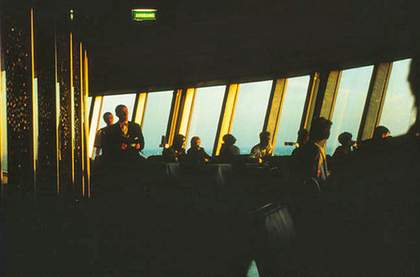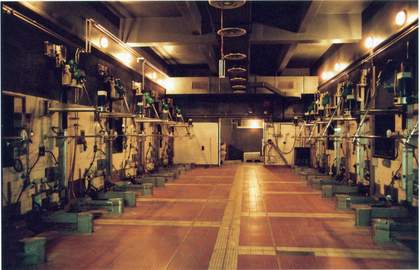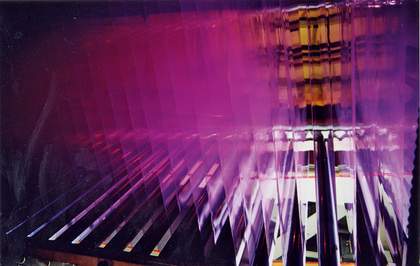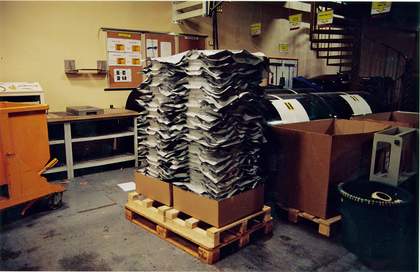Tacita Dean’s film work presents a single, constant challenge: to look ever more closely in search of things that may in fact never be evident from the frame itself. Most of the commentary on her now extensive filmography begins with the point that she is, above all, a connoisseur of structure, creating moving images that speak through elaborate composition and intricate juxtaposition.

Tacita Dean
Fernsehturm 2001
Colour photogravure, edition of fifteen
30.3 x 77 cm
Courtesy Frith Street Gallery, London © Tacita Dean
Others have pinpointed hers as a film of silence and elision, giving little away to the uninitiated, but full of surprises for the knowing. The primacy of the immediately visible fights with the weight of the contexts which she so conscientiously chooses, precisely for the relations they bear to larger truths; the way they specifically instantiate historical dynamics or make concrete our vaguest but most firmly held perceptions. Her places and people are overdetermined, which is a way of saying that they mean something more than they seem to at first glance. But perhaps the most important thing to note about her art is how these structured images and her stories unfold over extended lengths of slow time.
Take one of her best pieces, Darmstädter Werkblock 2007, which looks for most of its long eighteen minutes like an exploration of an empty room, which it is. The camera pans the space, exploring the frayed fringes of its empty, textile-clad, burnt brown walls. It settles on holes, tears, seams and faded spots marking where placards used to hang. We are formally intrigued, but also curious why we should care so much about this particular empty room in what we can vaguely sense is a museum. Perhaps we are even a little bored. Only later – not in the film itself, but in the accompanying materials – are we told that these rooms usually house the “Block Beuys”, a section of the Hessisches Landesmuseum in Darmstadt arranged by Beuys himself over the decade and a half between its opening and the artist’s death. The Block is mired in controversy now that the walls, which are actually left over from when the rooms showed medieval artefacts, but which evoke and mirror Beuys’s own work, are slated for renovation.
Another film, Palast (2004), works similarly. Perhaps the most fraught building in the Berlin art scene of the new century, this former GDR entertainment and cultural complex stood abandoned across from the Museumsinsel (Museum Island), doomed to demolition by a coalition of forces including a nostalgia for imperial architecture on the part of German conservatives, the inability of the cultural authorities to come up with a convincing plan for transforming it into a muchneeded kunsthalle and, perhaps most importantly, the carcinogenic asbestos found throughout its structure. Dean’s response at a moment when the debate had been decided but not entirely made public, was to look at the building, inside and out. Berlin, where Dean still has her studio, has proven an especially good city in which to think through these issues of time, both filmic and historical. One breakthrough came in 2001 with Fernsehturm, when she filmed a day fading into night in the revolving restaurant at the top of the iconic television tower on Alexanderplatz. Elderly ladies out for afternoon tea morph into businessmen on expense accounts, waiters move back and forth, and as night comes, a kitschy electronic keyboardist appears. The sound is only ever ambient. It is a moving piece, about the natural passage of time inside a monumental structure, lyrical for the way in which it juxtaposes the gravitas of governmental architecture and the incidental nature of the human interactions that take place inside it, particularly as the order in which the tower was built to function has collapsed. The drawn-out temporality of the film itself plays off the longer historical arc into which she is inserting this particular document of it. The eclipse of old orders, and the emergence of new, less easily defined ones, seems to preoccupy Dean, and not just in her work. Earlier this year she famously circulated a petition to Kodak to keep alive the 16 mm film that is her signature medium. The analogue world is my only world, she has said, swearing that she would rather retreat from art entirely than succumb to the digital trend that has already taken over so many of her colleagues.

Stills from Tacita Dean’s Kodak (2006)
16 mm colour, optical sound, 44 min, edition of four
Courtesy Frith Street Gallery, London © Tacita Dean

Stills from Tacita Dean's Kodak (2006)
16 mm colour, optical sound, 44 min, edition of four
Courtesy Frith Street Gallery, London © Tacita Dean

Stills from Tacita Dean’s Kodak (2006)
16 mm colour, optical sound, 44 min, edition of four
Courtesy Frith Street Gallery, London © Tacita Dean
The “Digital Revolution”, as a recent New Yorker anthology has termed it, is indeed as solid an historical force as the Industrial Revolution before it, yet one whose full extent we remain incapable of acknowledging as we live in its midst. Of course her resistance to it may ultimately prove futile, much as Ai Weiwei’s resistance to the Communist Party of China apparently has. None the less, this articulation of a nearly political stance, one ultimately based on a pluralism of method, imbues her work with yet another level. As Dean said in a Guardian article back in February: “Digital is not better than analogue, but different. What we are asking for is coexistence: that analogue film might be allowed to remain an option for those who want it, and for the ascendency of one not to have to mean the extinguishing of the other.”
In the same text, she wrote of the difference between film and digital as “not only emulsion versus pixels, or light versus electronics, but something deeper – something to do with poetry”.This poetry is exactly what she explored in one of her landmark films, Kodak (2006), a 45-minute examination of the production process of celluloid itself at a French factory fated for early closure because of a lack of demand. A film about the making of film, it hinged on the sort of super-aestheticised conceit that has become her staple. This is a tactic which allows her to turn even time itself into a structural device, as she did in 2008 with a film called Amadeus, which depicts a 50-minute crossing of the English Channel in a small fishing boat of the same name.
In recent years, Dean has devoted herself to making short biographical films about other artists, again laced with the layers of references that link them inevitably to their time. The most recent in the series, released earlier this year, is titled Edwin Parker and depicts an ordinary day in the life of Edwin Parker (Cy) Twombly, the eminent 83-year-old painter (who died this July), at work in his Lexington, Virginia, studio. It opens with a shot of flowers blowing in the wind, glanced through a slotted fence – the sort of contrast between stern horizontals and flitting gestural lines that we know from Twombly’s art, which actually echoes the endpapers of a catalogue of the artist’s own work that he looks at during the course of the film. At one point he sits to read the Financial Times, and flips to a lunchtime interview with the mega-dealer Larry Gagosian. We can see only the headline (“Once I Started, I Couldn’t Stop”) and the immediately recognisable caricature, but the knowing viewer would suspect that Twombly himself – his Rome studio long speculated to be the reason Gagosian threw his international expansion into overdrive by opening a space there in 2007 – is mentioned in the article, and he is. (“One of the greatest joys of my life has been working with Cy,” Gagosian says after finishing his swordfish.) At one key moment Twombly pages through the catalogue for an upcoming Sotheby’s sale, pointing out the good and bad pieces to his associate; he appears blurred in the background, the camera focused on jars of acrylic paint, and specifically on their brand label, “GOLDEN”. In the end these films, which function above all as meditations on time, share a common fascination with the texture of the everyday. Here, narrative is subsumed to evocation, and evocation resides ultimately in the passage of undifferentiated, slowly passing seconds, 24 frames each.
